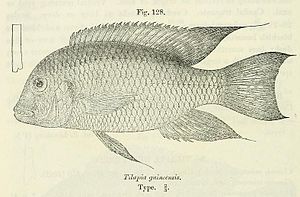Guinea cichlid
| Guinea cichlid | ||||||||||||
|---|---|---|---|---|---|---|---|---|---|---|---|---|

Guinea cichlid - drawing from Catalog of the fresh-water fishes of Africa in the British Museum of Natural History by George Albert Boulenger |
||||||||||||
| Systematics | ||||||||||||
|
||||||||||||
| Scientific name | ||||||||||||
| Coptodon guineensis | ||||||||||||
| ( Günther , 1862) |
The Guinea cichlid ( Coptodon guineensis ) is a species of fish from the genus Coptodon in the family of the cichlids (Cichlidae), which occurs on the west coast of Africa from the south of the Western Sahara ( Sebkha d'Imili ) to the mouth of the Cuanza in Angola .
features
The fish species can reach a length of 25 to 30 cm. It is high back and strongly flattened on the sides. The head profile is clearly rounded. The basic color of the fish is gray to whitish with a silvery, brownish or greenish tinge, the back is light or dark gray-green, the belly whitish. The base of the scales on the flanks is dark. Depending on the mood, the fish show six to nine poorly visible dark transverse bars or two dark vertical stripes. The lower cheeks, chest and abdomen are red, the throat of adult fish is black. The upper snout area is dark green. The fins are gray to transparent. The caudal fin is unspotted, its upper part is gray, the lower part is yellowish. The lower pharyngealia is as long as it is wide, and the anterior section is shorter than the dentate area. The fish have ten or fewer gill rakes on the lower branch of the first gill arch.
- Fin formula : dorsal XIV – XVI / 12–13, anals III / 8–10.
- Dandruff Formula 29–30 (SL), 30–31 (mLR)
Way of life
The Guinea cichlid lives on the Atlantic coast of Africa in brackish water , in protected marine regions, it rarely rises in the fresh water of the flowing rivers. It feeds on shrimp, mussels, plankton, growth and detritus . Guinea cichlids spawn in pits in the bottom of the water that are dug by the male or both parent animals. Both parents take care of eggs and fry. The fish larvae hatch after two to three days and swim free after about six days. Guinea cichlids can also reproduce in pure sea water.
Systematics
The Guinea cichlid was first described in 1862 by the German zoologist Albert Günther under the scientific name Chromis guineensis . The species was later assigned to the genus Tilapia and placed there in the subgenus Coptodon . In a comprehensive revision of the tilapine cichlids in 2013, Coptodon was raised to the rank of an independent genus.
Investigations of the mitochondrial DNA show that the Guinea cichlid is a species complex of morphologically very similar species, which consists of three or four different evolutionary lines. One of these lines, its range includes the Terra typica of the species in Ghana , is closely related to the West African freshwater species Coptodon dageti , Coptodon discolor and Coptodon louka . These three species likely evolved from populations of this lineage that moved to permanent freshwater life. Another line of the Guinea cichlid is related to two currently invalid species from Senegal, which were described by the French zoologist Auguste Duméril in 1861 as Tilapia affinis and Tilapia polycentra , but were later synonymous with the Guinea cichlid , as well as with Coptodon camerunensis and of a previously undescribed species ( Coptodon sp. aff. louka 'Samou'). One or two other lines from Nigeria and Gabon belong to the same clade as Coptodon nyongana , Coptodon rendalli and Coptodon zillii . For morphological reasons, this line has so far been included in Coptodon guineensis , but is only distantly related to the other lines of the Guinea cichlid.
Individual evidence
- ↑ Jean-François Agnese, Halima Louizi, André Gilles, Ouafae Berrada Rkhami, Abdelaziz Benhoussa, Abdeljebbar Qninba and Antoine Pariselle. 2018. A Euryhaline Fish, Lost in the Desert: The Unexpected Metapopulation Structure of Coptodon guineensis (Günther, 1862) in the Sebkha of Imlili. Comptes Rendus Biologies. DOI: 10.1016 / j.crvi.2018.01.002
- ↑ Günther Sterba : Freshwater fish of the world. 2nd Edition. Urania, Leipzig / Jena / Berlin 1990, ISBN 3-332-00109-4 , p. 807.
- ↑ a b Anton Lamboj: The cichlids of western Africa. Publisher: Natur und Tier, 2006, ISBN 3-86659-000-8 , pp. 78-79.
- ↑ Melanie Stiassny, Guy Teugels & Carl D. Hopkins: The Fresh and Brackish Water Fishes of Lower Guinea, West-Central Africa, Volume 2 , ISBN 978-90-74752-21-3 , p. 367.
- ↑ a b c Guinea cichlid on Fishbase.org (English)
- ^ Andreas R. Dunz, Ulrich K. Schliewen: Molecular phylogeny and revised classification of the haplotilapiine cichlid fishes formerly referred to as “Tilapia”. Molecular Phylogenetics and Evolution, Volume 68, Issue 1, July 2013, doi: 10.1016 / j.ympev.2013.03.015
- ↑ Kide et al .: Cichlids of the Banc d'Arguin National Park, Mauritania: Insight into the diversity of the genus Coptodon. Journal of Fish Biology (2016) doi: 10.1111 / jfb.12899